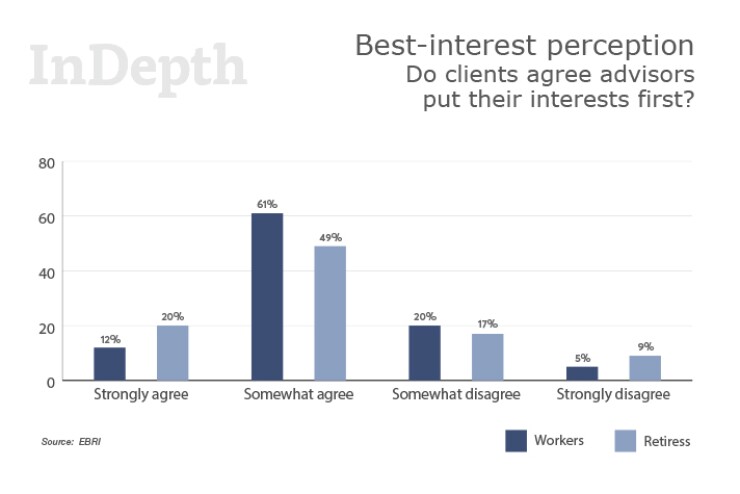Everyone wants to live comfortably during their retirement. Unfortunately, many people aren’t able to think far enough ahead to achieve that.
“People are not good at thinking about the future in a way that allows them to plan and executive well,” says Andrew Porter, director of behavioral finance, Merrill Lynch.
Indeed, before advisors can create a retirement plan with their clients, they need to know how far into the future their clients think, says Steve Wendel, head of behavioral science at Morningstar. Without a clear picture of their future, clients will not save enough for retirement, he says.
On one end of the spectrum, some clients know exactly what they want their future to look like. They know where they want to live, what they want to be doing and what they want their house to look like. Other clients only have a vague picture in their minds of what they want their retirement to look like. They are so focused on the present that they don’t consider their future seriously. These clients will need more help in the retirement savings and planning process, Wendel says.

He says advisors can figure out where their clients fall on this spectrum by simply asking them this question: “When you think about the future, how clear is the picture?”
While trying to understand their clients, advisors also need to find out what a client’s core values are. They need to understand why their clients care about investing. “Do they have a quest? Do they want to give to charity?” Wendel says. Finding out a client’s core values will inform advisors on how to help manage the ups and downs of investing down the road.
LOOKING INTO THE FUTURE
One of the reasons clients don’t save enough even when they have a plan is because their retirement is too abstract for them. Wendel’s advice for advisors is to ask their clients very specific questions to make their retirement more real to them. Such as: “Where will you be living? What does your house look like? What are you doing? What are your friends doing?” he says.
Age-progression software is one way advisors can make the future less abstract for clients. Showing clients a concrete picture of what they might look like when they retire can prompt them to contribute more to retirement.
Research suggests that when people are asked these questions, they realize on their own that they are not saving enough for retirement, he says.
“An advisor’s job is to help you see your future better,” Porter says.
To that end, one online, digital tool advisors can use to make the future less abstract for clients is age-progression software. They can take a picture of their client and use an age-progression application to show them what they may look like when they retire, Wendel says. Behavioral research shows that when you give investors a concrete picture of their future selves, they will contribute more to retirement.
Once clients have a clearer picture of what they want their retirement to look like, advisors can ask their clients to make a list of all the likely expenses they will have when they retire. That list can give them a more accurate number of how much they will need to save.
IMPLEMENTING THE PLAN
After a retirement plan has been made, advisors will encounter many hurdles as they try to help their clients reach their retirement goals. The biggest challenge can be the old standby: clients simply don’t put aside enough money for savings. One way advisors can keep their clients on track is with automatic savings features, says Porter.
Clients can enroll in employer retirement saving plans that automatically deduct a percentage of their salary. They can also enroll to have that amount automatically increased each year.
Rick Mason, a senior advisor for Voya’s Behavioral Institute for Innovation, agrees that it is important to automate the retirement savings process for clients as much as possible. He says that it will help them overcome the inertia that keeps them from saving.
However, Mason notes that the default option for automatic enrollments may not be enough for clients to achieve their retirement. They may only save 1% or 2% when a client needs to be saving 3% to 6%. Advisors need to work with their clients to customize those options for them.
MANAGING THE UPS AND DOWNS
Some advisors invest conservatively so their clients don't panic when there is volatility. However, this usually is not the right approach.
“The problem is avoiding volatility also can mean avoiding meeting your goals,” Wendel says. Instead, advisors need to find another way to manage a client’s fears about losing the money they have invested.
Advisors can manage a client’s fears or urges to pull out of the market when it falls by using narratives. Clients think that when the market goes down, it will continue to go down, Wendel says. He says, advisors need to explain to their clients that when the market goes down that is the time they should be investing more.
While explaining to clients how they should view ups and downs in the market, advisors should tie the conversation back to a client’s values. They should remind their clients that if they pull out of the market they won’t be able to save enough to donate to charity or travel or do whatever it is they want to do in their retirement, Wendel says.
Whatever tools advisors use, Mason says, it is important to use techniques that allow their clients to act immediately. They should use tools that will eliminate the amount of effort that is needed by their clients. Reducing the effort clients need to expend will help them overcome inertia preventing them from saving and achieving their retirement goals.
After all, a good plan is only effective if clients can stick to it, Porter says.





